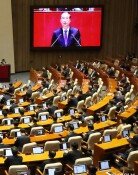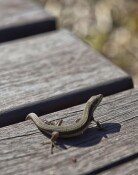7 of 8 history textbooks fail to mention `Aungsan terrorist attack
7 of 8 history textbooks fail to mention `Aungsan terrorist attack
Posted October. 09, 2013 06:41,
The terrorist attack at Aungsan Cemetery in Burma (currently Myanmar), which marked the 30th anniversary on Tuesday, is being forgotten in Korean society. Notably, most history textbooks even failed to mention basic facts regarding the incident.
A review of eight high school history textbooks for 2014 conducted by The Dong-A Ilbo revealed only one of them mentions the Aungsan bombing. The textbook published by Kyohaksa notes that North Korea detonated bombs at Aungsan cemetery on Oct. 9, 1983 to assassinate President Chun Doo-hwan who visited Myanmar, and killed 17 South Koreans including deputy prime minister Seo Seok-joon and four Myanmar citizens. The other seven textbooks do not mention the incident at all. The Kyohaksa textbook is the only one that also mentions the bombing of Korean Air Flight 858 in 1987, which is another major international terrorist attack committed by the North.
Most other textbooks heavily deal with reconciliation and cooperation between the two Koreas by handling inter-Korean relations after the 1980s in chapters such as North Koreas change and efforts by the two Koreas to achieve peaceful reunification. They also described in details brutal oppression of the May 18, 1980 Democratization Movement in Gwangju committed by the then military regime, but did not allocate any pages on inter-Korean relations during the Chun administration, which must be one of the reasons for disregarding the Aungsan terrorist attack.
There are mounting voices who raise concern about the situation where major past incidents" are being forgotten this way amid the Norths lingering provocations toward the South. North Korea, which cannot afford to stage a full-blown war due to a gap in national prowess vis-à-vis South Korea, can only focus on unconventional warfare using its elite troops, and the situation is intensifying, said Yoo Dong-yeol, senior researcher at the Police Science Institute. I regret that the publics recognition in South Korea about the threat of North Koreas aggression is dimming. North Koreas intelligence bureau that masterminded the Aungsan bombing was merged with the operation bureau around February 2009 and expanded to become the general intelligence bureau under the National Defense Commission.
In fact, since the Norths inauguration of the general intelligence bureau, Pyongyangs practice of aggressions is moving toward the trend of non-reconciliatory, military adventurism, a situation that is different from the past. The North conducted its second nuclear test in May 2009, and staged the Daecheong Naval Battle in the West Sea in November that year. The North also sank the South Korean naval corvette Cheonan through its torpedo attacks in March 2010, and launched artillery attacks on the South Korean island of Yeonpyeong in November that year, as it continued military-led aggressions.
Most of the eight history textbooks except Kyohaksas briefly mention that military skirmishes between the two Koreas occurred in the west coast, and (The Norths) sinking of the Cheonan and artillery attack on Yeonpyeong Island increased tension in inter-Korean relations. Three textbooks had no mention about the two incidents whatsoever.







